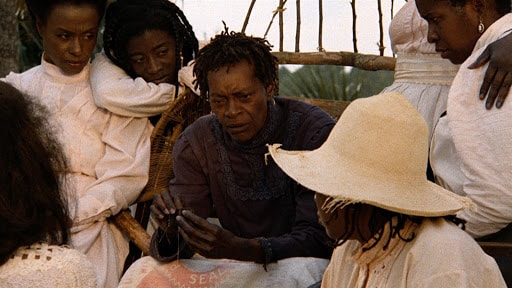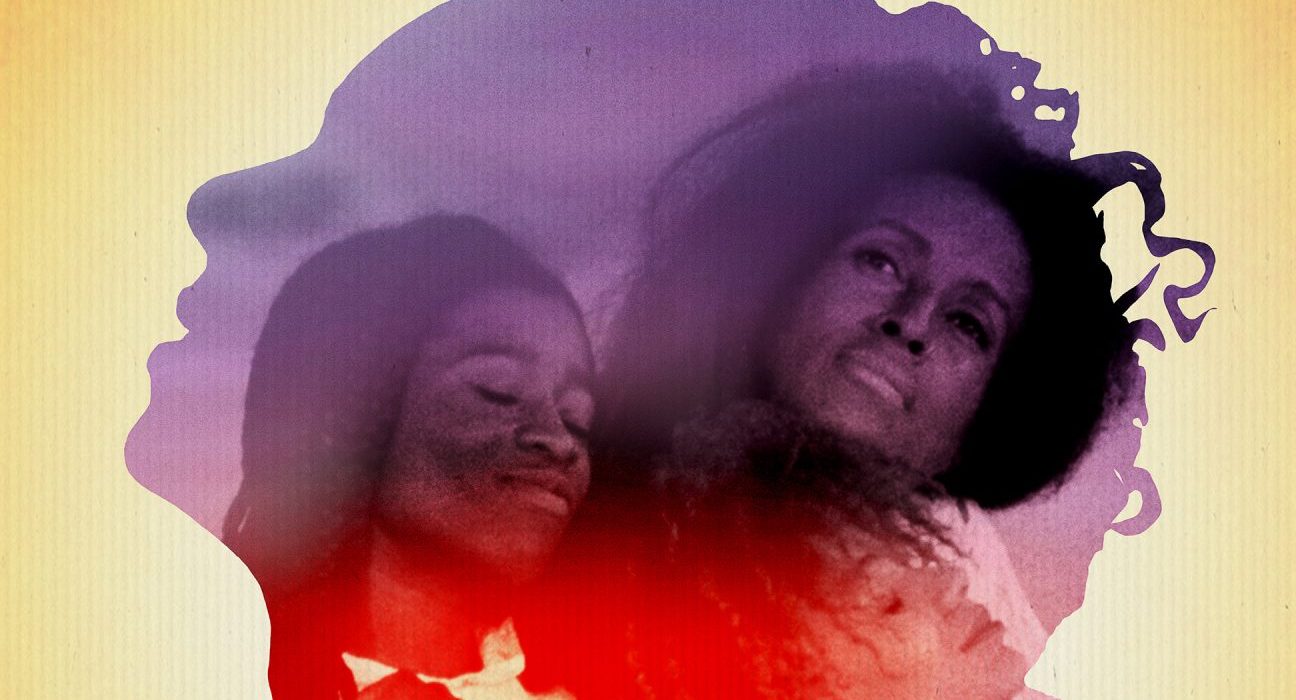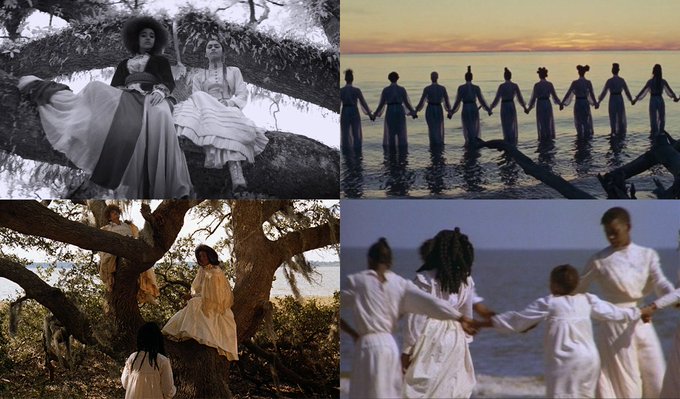Starring: Cora Lee Day, Alva Rogers, Barbara O and Adisa Anderson
Rated: PG Drama/History/Romance
Spanning a one-day period and set on Dawtah Island in 1902, Daughters of the Dust presents a narrative focused on three generations of Gullah women in the Peazant family. These women are Nana Peazant, the Afro-spiritual matriarch who wants her family to stay on the island to retain their ancestral ties and customs; granddaughter, Yellow Mary, a bohemian who lives on the mainland; granddaughter, Viola, a devout Christian who prepares to leave their island; and granddaughter, Haagar, who desperately wants to leave because of the advancements of “civilized” society of the mainland. There is also Iona, Haagar’s daughter, who is secretly in love with St. Julien Lastchild, and wants to stay on their island. Finally, there is granddaughter-in-law, Eula, who is married to Eli and expecting a child. However, they are unsure of the paternity because she was raped by a White man on the mainland.
The film is narrated by The Unborn Child, the future daughter of Eula. Her life, yet to physically begin in This Realm, is greatly influenced by her ancestors and African spiritualism. In a powerful scene, Nana Peazant speaks on the love and value of the Unborn Child, “We are two people in one body. The last of the old and the first of the new.” Supporting characters include Daddy Peazant, the patriarch; Eli, Eula’s husband and Nana’s grandson; Mr. Snead, a photographer from the mainland who takes portraits of the islanders before the final departure from the island; Trula, the lover of Yellow Mary; St. Julien Lastchild, an Indigenous American, who refuses to leave the island; and Bilal Muhammad, a Muslim who also lives on Dawtah Island.

The plot is told in a circular pattern to illustrate the significant phases of the Gullah culture: the Past, the Present and the Future. Dash references this type of storytelling akin to a “griot”, as a griot is a human repository of oral tradition. A griot can be a storyteller, historian, poet, singer or artist and is highly respected in their community for their wisdom. Spirituality and religions that Blacks have practiced are featured throughout the film and involve the African practices, ancestral prayers and Gullah language of Nana, the Christian teaching of Viola and the Islamic prayer of Bilal. Also, the essentiality of history and veneration of ancestral ties are constantly revisited throughout the film. This involves the account shared by Eli and Eula at the family meal of the uprising and mass suicide of enslaved Igbo at Igbo Landing in 1803. The film ends with each member of the Peazant family having to decide whether to remain on the island and preserve their way of life or leave for the mainland to begin a new one … who will leave and who will remain?
Julie Dash developed a story that would become the screenplay to Daughters of the Dust while researching the Geechee and Gullah cultures. Production began in 1988 when she was awarded $800,000 in financing from the Public Broadcasting Service (PBS). The film would be completed and enter select theatres in 1991.
Daughters of the Dust garnered critical praise for its use of authentic Gullah patois without English subtitles; complex, nonlinear storytelling; lush music composed by John Barnes; and its gorgeous cinematography and visual imagery by Arthur Jafa, the former husband of Dash. Her creation of this film presented the reality of the unique Gullah community that was able to retain many of its Africanisms, despite the American system of slavery, and the imperative value of Black womanhood.
After the release of Daughters of the Dust, the book, Daughters of the Dust: The Making of an African American Woman’s Film, was published in 1992. It was co-authored by two pillars of Black women’s literature, Toni Cade Bambara and bell hooks. In 1999, Daughters of the Dust: A Novel, was published. It is a sequel set during the Harlem Renaissance in the 1920s about the protagonist, Amelia Varnes, the granddaughter of Haagar. A Harlemite who studies anthropology at Brooklyn College, she visits Igbo Landing of Dawtah Island to meet her mother’s relatives and learns about her ancestral culture, kin, folklore and her place and purpose in This Realm. The novel earned positive praise and was nominated for the NAACP Image Award for Fiction.
Daughters of the Dust continued to gain high accolades. In 2004, it was selected for preservation in the United States National Film Registry by the Library of Congress as being “culturally, historically, or aesthetically significant.” Its images would significantly influence the creation of Lemonade, the critically-acclaimed and multiple award-winning 2016 visual album of Beyoncé. A salute to Black woman-ity, it, too, features narratives told from different vantages, as represented by each segment. Lemonade discusses everything from Black motherhood, Sistahood, food, water, landscape and love. Two in particular are highly influenced by Daughters of the Dust, “Formation” and “Love Drought”. The former shows her and her dancers in formal dress inside a parlor reminiscent of the early 1900s. The latter features Beyoncé and her dancers, all dressed in white dresses, seeming to walk on water to return to their “home”, a la Igbo Landing rebellion, as discussed by Eula and Eli in the film.
In 2016, Yohana Desta interviewed Julie Dash for her article, “How Beyoncé’s Lemonade Helped Bring a Groundbreaking Film Back to Theaters”, published by Vanity Fair. When asked about her impression and feelings regarding the renewed interest in Daughters of the Dust, fueled by Lemonade, she responded, “I was very pleased. Lemonade is just – it breaks new ground. It’s a masterpiece.” Dash considers the epic video album, “… a tone poem, a visual tone poem with various stories going on – vignettes. It’s just all visual and it’s like yes … I just love what she and her sister [Solange] do, what they represent … they reimagine and redefine the Diaspora. And it’s just like, ugh – sumptuous. Just sumptuous. I loved it. Every bit of it.”
In celebration of its 25th anniversary, the Cohen Media Group restored and distributed Daughters of the Dust in 2016. Though it was already planned, the excitement created by Lemonade, according to Dash, sped up the release.
For greater enlightenment...
-
“Daughters of the Dust” 2K Restoration (US Trailer)

-
Julie Dash - On “Daughters of the Dust” 25th Anniversary Restoration

-
Gullah Traditions of the South Carolina Coast

-
PBS – Gullah Culture

-
“A Vanishing History: Gullah Geechee Nation”

-
NOURISH -Dr. Howard Conyers: “Gullah Geechee Food Traditions”

-
“LEMONADE” Trailer - HBO


